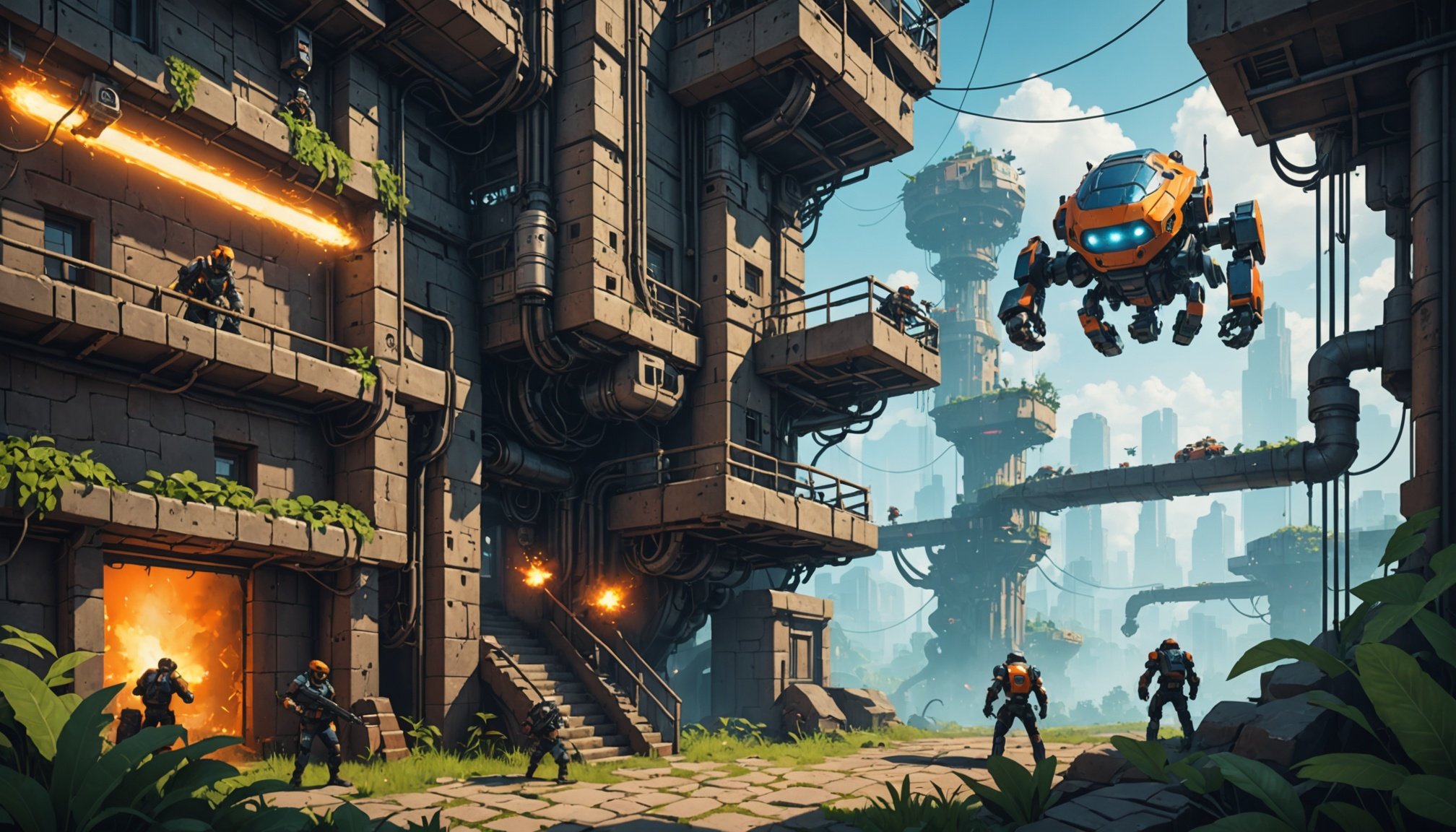Revolutionizing Platformer Games: Harnessing Neural Networks for Smart, Adaptive Enemy AI
The world of video games is on the cusp of a significant transformation, driven by the integration of artificial intelligence (AI) and machine learning. One of the most exciting developments in this realm is the use of neural networks to create smart, adaptive enemy AI in platformer games. This technology is not only enhancing the gaming experience but also redefining the way game developers approach game development.
The Evolution of Enemy AI
In the past, enemy AI in video games was often simplistic and predictable. Enemies would follow predefined paths or react to player actions in a limited and scripted manner. However, with the advent of neural networks and machine learning, the landscape is changing dramatically.
This might interest you : Harnessing machine learning magic: crafting lifelike npc animations for an engaging open-world gaming experience
From Scripted to Adaptive
Neural networks allow for the creation of enemy AI that can learn and adapt in real time. This means that enemies can adjust their behavior based on the player’s actions, creating a more dynamic and challenging experience. For instance, in games like STALKER 2, the upcoming patches aim to enhance the AI of NPCs and enemies, making them more realistic and reactive to player interactions[1].
How Neural Networks Work in Game Development
Neural networks are a type of machine learning model inspired by the structure and function of the human brain. In the context of game development, these networks can be trained on vast amounts of data to learn patterns and behaviors.
Also to discover : Exploring lively wildlife realms: utilizing real-time biome insights for interactive ecosystem simulations in gaming
Training and Learning
The process begins with data collection. Game developers gather data on player behavior, enemy interactions, and game outcomes. This data is then used to train the neural network, which learns to predict and respond to various scenarios. For example, a neural network can be trained to recognize when a player is using a specific strategy and adapt the enemy’s behavior to counter it.
- Data Collection: Gather player behavior data, enemy interactions, and game outcomes.
- Training: Use the collected data to train the neural network.
- Deployment: Implement the trained neural network in the game.
- Real-time Adaptation: The neural network adjusts enemy behavior based on real-time player actions.
Enhancing Gaming Experiences
The integration of neural networks in platformer games offers several benefits that significantly enhance the gaming experience.
Dynamic Difficulty Adjustment
One of the most notable advantages is the ability to adjust the difficulty level in real time. Neural networks can analyze a player’s performance and adjust the challenge accordingly, ensuring that the game remains engaging but not overwhelmingly difficult. This is exemplified in games that use AI to determine the difficulty of challenges and adapt them to the player’s skill level[3].
Realistic NPC Behavior
Neural networks enable NPCs to exhibit more realistic and interactive behavior. For instance, in games like The Witcher 3 and Red Dead Redemption 2, NPCs can understand and respond to player actions in a more human-like manner, making the game world feel more immersive and alive[2].
Personalized Experiences
AI can also personalize the gaming experience by analyzing player preferences and behavior. Games can adapt their content, including quests, dialogues, and even enemy encounters, to provide a unique experience for each player. This personalization is a key feature of modern gaming, making each playthrough distinct and engaging[3].
Table: Applications of Neural Networks in Video Games
| Application | Description | Examples of Games |
|---|---|---|
| Dynamic Difficulty Adjustment | Adjusts game difficulty based on player performance | Left 4 Dead |
| Realistic NPC Behavior | NPCs react realistically to player actions | The Last of Us Part II |
| Personalized Experiences | Adapts game content based on player preferences and behavior | Watch Dogs: Legion |
| Generative Content | Creates unique game environments and content | No Man’s Sky |
| Real-time Adaptation | Enemies adapt their behavior in real time based on player actions | STALKER 2 |
Challenges and Future Directions
While the integration of neural networks in game development is revolutionary, it also comes with its set of challenges.
Development Complexity
Creating intelligent and adaptive AI is a complex task that requires significant resources and expertise. Developers must balance the need for realistic AI with the technical limitations of current hardware and software.
Ethical Considerations
As AI becomes more sophisticated, ethical questions arise. For example, how much should AI be allowed to influence the gaming experience? Ensuring that AI enhancements do not compromise the integrity of the game or the player’s experience is crucial.
Future of AI in Gaming
The future of AI in gaming looks promising, with several emerging trends set to redefine the industry.
Adaptive AI
Future games could use AI to analyze players’ emotions in real time, adjusting the game to match their emotional state. This could be achieved through biometric sensors or facial recognition technology, creating an even more immersive experience[3].
Generative AI
Generative AI can create vast, unique game worlds and content, such as in No Man’s Sky, where AI generates planets, creatures, and environments on the fly. This technology has the potential to offer endless gaming experiences without the need for manual content creation[3].
Practical Insights for Game Developers
For game developers looking to harness the power of neural networks, here are some practical insights:
Start with Data
The foundation of any successful AI implementation is high-quality data. Ensure you collect comprehensive data on player behavior and game interactions.
Use Reinforcement Learning
Reinforcement learning is a powerful tool for training AI models to make decisions in complex environments. It can be particularly effective in teaching AI to adapt to player strategies.
Test and Iterate
AI models need continuous testing and iteration to ensure they perform as intended. Use feedback from players to refine and improve the AI over time.
Quotes from Industry Experts
- “We want to assure you once again that we will do our best to constantly improve your experience on STALKER 2. We are really grateful for your feedback and suggestions for improvements.” – GSC Game World[1]
- “The adoption of new natural language learning techniques of AI allows NPCs to understand and respond interactively to all actions performed by players, making dialogues unpredictable and more immersive.” – Jesuisungameur[2]
- “The future of artificial intelligence in the video game industry looks bright and full of promises. Imagine games capable of analyzing players’ emotions in real time and adjusting the game accordingly.” – Mobilecube[3]
The integration of neural networks in platformer games is a game-changer, offering a more dynamic, adaptive, and immersive gaming experience. As AI technology continues to evolve, we can expect even more sophisticated and personalized gaming experiences. For game developers, the key to harnessing this power lies in data collection, reinforcement learning, and continuous iteration. The future of gaming is indeed bright, and AI is at the forefront of this revolution.
Future Trends in Game Development with Neural Networks
As technology evolves, neural network trends are increasingly influencing game development. One of the most exciting prospects is the future of AI, where artificial intelligence can create more immersive experiences. This involves game development innovations that allow games to become more adaptive and responsive to players’ actions.
In platformer games, emerging trends such as procedural generation and player-adaptive systems are set to redefine traditional levels. By learning from player behaviour, AI can continuously enhance gameplay, making each run unique and engaging. Powered by neural networks, these systems fine-tune their responses, providing challenges tailored to individual skill levels.
Predicting how AI in game environments will evolve showcases potential for increasingly sophisticated non-player characters (NPCs). These NPCs can adapt dynamically, interacting with players in nuanced, intelligent ways that reflect players’ actions and decisions. This ensures a compelling narrative and gameplay experience, responding seamlessly to a player’s individual style and choices.
Despite these exciting prospects, ethical considerations must be addressed. The integration of adaptive AI poses challenges regarding data privacy and the balance of fairness in competition. As neural network applications grow, developers need to consider these challenges to create innovative yet ethical gaming experiences.






